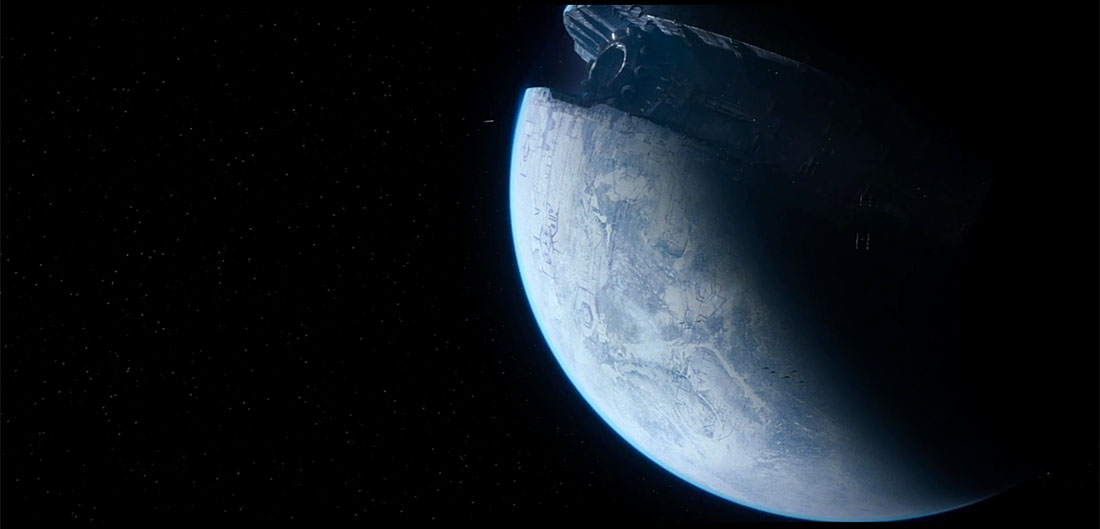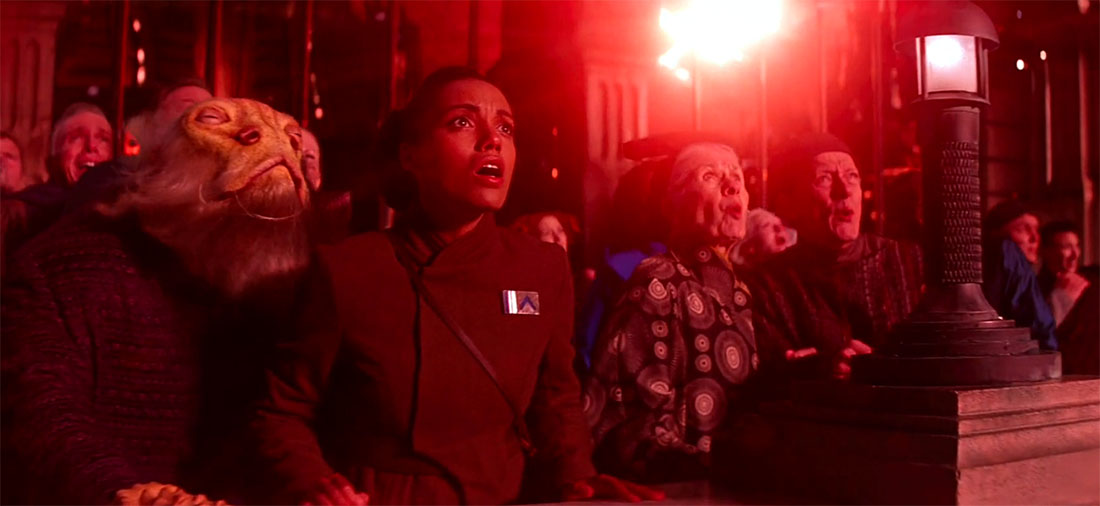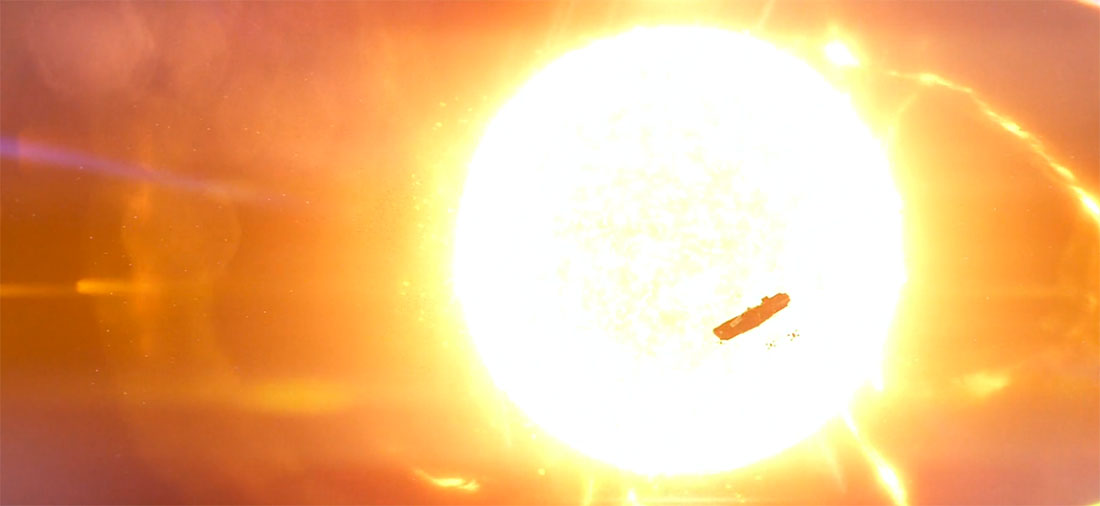I was horribly ill back in December when Star Wars: The Force Awakens was released. I dragged myself to the theater multiple times to see it through a sequence of flu, strep, and pneumonia, but I wasn’t able to devote the time necessary to write-up my thoughts on it immediately. (And after only a short while, it seemed somewhat redundant.) However, with the film’s recent release to home video and in celebration of the week of May 4th, there are a couple of things I’d like to say.
First, and by way of context: I love the film. I think it’s great. The new characters are fabulous. J.J. Abrams, by and large, is remarkably successful in capturing Lucas’ directorial style while still being true to his own.
There’s really only one thing I don’t like. And it probably won’t be terribly surprising:
STARKILLER BASE
When Starkiller Base first appeared on screen my immediate reaction was, like many people, “Really? We’re doing the Death Star again?”
The most remarkable thing about the Starkiller Base stuff is how utterly irrelevant it is. If you removed it from the movie entirely, virtually nothing would change for the main characters. (Han, Chewie, and Finn still go to the First Order’s base to rescue Rey. Han and Kylo Ren still confront each other. Et cetera.)
There’s also the fact that literally everything to do with the Starkiller Base is poorly done: They fail to establish the stakes for the first time it’s fired (it’s a planet that’s scarcely been mentioned and you see a bunch of people die that you have no reason to care about). The entire thing is a giant plot hole (it needs to consume the system’s sun in order to fire at the end of the film, but doesn’t do that the first time it fires). The off-hand reference to the entire New Republic navy being stationed on the surface of Hosnian Prime doesn’t make any goddamn sense. (It’s as if someone told the story of Pearl Harbour, but for some reason the entire American navy was drydocked in Iowa.) The plan for destroying it is literally the characters saying, “Fuck it. You saw the first film and ROTJ, right?” The attack fleet sent to destroy it doesn’t make any sense. (Why would you only send some of your ships on this mission?) For some reason, after being briefly spied so that Han can suggest bombing the regulator, the X-wing fight is never seen nor heard again by anyone on the ground. And the film couldn’t even be bothered to correctly track the number of ships which had been destroyed during the battle. (Count the number of X-wings that arrive; the number of X-wings destroyed just on screen; and then count the number of X-Wings that leave.)
So, when I’m given the godlike powers to fix stuff that doesn’t make sense in movies, I would probably just eliminate the whole thing. (Because, honestly, we don’t need to go back to the “duplicate of the Death Star” well again. It was already a mistake in ROTJ. The Star Wars universe is big enough that we can explore other cool sci-fi ideas.)
But let’s say that you wanted to keep it. (There’s some cool thematic elements to the whole “light going out” thing with parallels between the sun and Kylo Ren. Plus, I’m guessing the whole “blowing up the government of the New Republic” is probably going to be significant going foward.) Here’s what you’d do:
- Starkiller Base doesn’t fire at the midpoint of the film. Instead, the Resistance would learn of its existence through some other means. (For example, Finn reveals the location of the base when debriefed about Rey’s capture. The Resistance sends scout ships — which is something they do in the film anyway — and have the “oh shit” moment of discovering what it is.)
- The mission to destroy Starkiller Base at the end of the film is to stop it from firing on the New Republic capital planet. This eliminates most of the grievous continuity errors.
- It also gives you the narrative space to add several scenes involving coordination between Leia and her contacts within the New Republic government. These scenes would nicely clarify some of the details on how the modern political landscape actually works in this film; it would also give you an opportunity to learn enough about the Republic and Leia’s allies in the Hosnian System so that its destruction is meaningful to the audience. (This doesn’t take a lot. The first film made the destruction of Alderaan relevant with just a handful of lines.)
- Finally, and this is the key thing, the mission fails. You hit basically all the same beats you do during the film as it was released (although with a few tweaks to improve the execution and eliminate the continuity errors), but with the key distinction that they don’t destroy it fast enough. You know how Luke destroys the first Death Star just before it can fire on Yavin 4? You have basically the same moment, except Po Dameron doesn’t manage to destroy the regulator until just after it’s fired.
This last point is important not just because it conserves the presumed narrative necessity of destroying the New Republic government, but because it single-handedly justifies the entire presence of Starkiller Base in the movie.
One of the great things about Star Wars is its use of narrative leitmotifs. (Something which is echoed in John Williams’ leitmotif-based scoring.) George Lucas, whatever his flaws as a filmmaker may be, was ingenious at taking common moments and, in mythic fashion, changing the perspective of them so that they commented on each other. (For example, despite the myriad flaws of the prequel films, the telling of Anakin’s fall and its parallels with Luke’s story radically transform the ending of ROTJ: In the context of the original trilogy, you really don’t believe there’s any risk of Luke falling. He’s the Hero. He’s going to be the Hero, right? But once you’ve seen Anakin — who was also the Hero — fall, that tells you something about Luke and adds tremendous depth to that final confrontation in ROTJ which is otherwise absent.)
But when you use a leitmotif you can’t just do the exact same thing again (only bigger!). You have to transform the moment. And I think transforming the destruction of the Death Star into the failure to stop Starkiller Base would definitely have a deeper thematic resonance here. (A lot of The Force Awakens reminds me of a Shakespeare quote: “The time is out of joint. O cursed spite that ever I was born to set it right.” And nothing would feel more out of joint than this twisted mirror of A New Hope.)
STAR WARS – FURTHER READING
The Plan of Palpatine
Star Wars: Episodes VII, VIII, and IX















I’m not sure I’d call the second Death Star in RotJ a mistake. I think the whole bit with it being intended as a trap and the charge time of the weapon being improved to be an effective weapon against the Rebel capitol ships is a significant enough difference.
As a trap, it really does make sense. Palapatine is leveraging the Rebels’ fear of the destruction the first Death Star could have brought and using it to lead them to rush into an assault without fully understanding what they’re dealing with. As a bonus, viewers already know how scary the Death Star is, without needing to establish the stakes of a new threat.
I agree that the Starkiller Base could have been done better. (By the way, wasn’t Luke Skywalker called Luke Starkiller in an early draft of the original script?) But, I think it was an important part of the recycling and reconstructing of the previous movies, particularly episodes IV-VI, which is clearly a theme of the movie (and one that I loved, but others hated). The key to me, though, is that despite having a super-duper Death Star replacement and an even more ominous substitute for the Emperor (he’s huge and you can’t even touch him), the key villain is an immature, conflicted dude with huge chips on his shoulders. We can see the living conflicts in Kylo Ren that never really played out in the robotic depiction of Anakin Skywalker (in the movies, at least). So, we get the contrast between a massive evil with massive power to commit evil and the servant of evil who despite his powers is a person of rather small will.
Star Killer base was the part I liked least about the film as well (that and the Han Solo pirate scenes). I haven’t had a chance to watch them yet but I heard that a bunch of the deleted scenes (which were most of the scenes with Leia) included some of the background information that you mention is missing.
I honestly wish they had just gone with the idea that it was the hidden base of the First Order that needed to be destroyed. No need for a super weapon. Send in the ground troops to disable the shield generator so the Resistance could bombard the base from orbit, and rescue Rey. That way you turn it into a mirror of the battle of Hoth with the good guys playing the role of the invaders and the bad guys playing the role of the retreators.
I agree with you wholeheartedly.
One subtle thing I do like about the Starkiller Base sequence: The reason the First Order isn’t prepared for the assault fleet is because Kylo Ren orders the hangars locked down to prevent Rey from escaping.
Yeah the whole Starkiller Base thing nagged at me too. Several problems were sticking out for me.
1) It’s based on the Death Star, a superweapon that was never effective (it would be as if we were still trying to build bigger battleships in favour of better aircraft carriers).
2) Captain Phasma immediately does exactly what she’s told to (basically high treason) as soon as a blaster is pointed her way.
3) What does the giant planet sized weapon DO once it has fired and consumed the sun? (I think it is said in the movie that they were in a binary star system initially which is why they could fire that first shot and still have a sun) Travel light years to find another sun? Presumably the planet doesn’t have hyperspace drives, so…
I’ve watched The Force Awakens quite a few times over the last few weeks. I hadn’t seen it except for once in the theater, and these viewings also included my children’s first look at the movie. (They were mildly traumatized by the climax of the movie. In a good way! We’ve had some good talks about it.)
The more I watch the movie, the better it hangs together. I had some critiques about Starkiller Base, much along Justin’s lines, but the more I watch it the less it bothers me. The plot works. Yeah, there could have been more establishment of the importance of The New Republic at the beginning/middle of the film, but I think that comes at a cost in the flow of the movie. One of the nice things about TFA is that it drops you right into the action, in the same way that the original Star Wars did.
One of the best things about the Starkiller Base sequence is that the original attack plan fails, and Han Solo’s band needs to improvise a new plan on the spot. It provides a nice contrast to A New Hope, where the plan runs to spec and just needs Luke Skywalker to execute it.
Re: Kylo Ren. I think he’s a fantastic villain. He is strong in the force and a serious, menacing opponent throughout the film. It’s great. But at the same time he is personally and emotionally weak. He’s a giant Darth Vader fanboy, and the movie paints this up as a weakness.
Darth Vader is one of film’s iconic villains. Clearly, TFA can’t match up to him. So they don’t try, and instead turn that into a strength: They make their villain try to live up to Vader’s reputation. I love that about it.
@gaynorvader: I think it would be potentially interesting to look at the Death Stars as fundamentally changing the nature of war in the Star Wars universe (with Starkiller Base being the natural escalation). Once both sides accept that reality and start building their own planet-killers, it would create a Cold War-esque stalemate of mutually-assured destruction. All kinds of space opera action can happen in that environment.
(Pretty sure that’s not the direction they’re going to go. But it would be interesting.)
Re: What does it do after consuming its sun. That would be the argument for embracing its “we’ve got one shot” nature. Having a weapon that you can use to wipe out the opponent’s capital without any fight or defense (as shown) is incredibly useful. Even ignoring the continuity error, when they decide to use that one-shot capacity to take out a Resistance base that has basically no defensive capacity whatsoever it’s just another thing that doesn’t really make any sense.
@robbbbbb: Yeah. Because it’s so largely irrelevant to the actual plot of the movie, I’ve found that the Starkiller Base stuff kind of quietly recedes further and further into the background as I’ve rewatched the film. I do think that it drops a film which had the potential to be on the same level as ANH and ESB down to the level of ROTJ. So… missed opportunity. But still a great film.
Re: Kylo Ren. I think he’s actually well-framed to become a villain who can stand toe-to-toe with Vader if he’s given three good films of character development. (No one is going to surpass Vader.)
Tangentially, what I actually consider to be the single biggest mistake in the prequel trilogy was the failure to develop a strong apprentice for Palpatine. (I suspect that this was a deliberate decision by Lucas not to show-up Vader, in much the same way that he deliberately chose not to show a hyperspace jump from inside the cockpit of a ship because he wanted that moment in ANH to still be an awesome new thing for people watching the films 1-6. But since the awesomeness of Vader can’t be diminished, it’s still a mistake.)
Ignoring all the other issues with the prequel trilogy, imagine that Darth Maul had escaped from Naboo at the end of TPM. Instead of Dooku in the second film, it’s Darth Maul who wounds Kenobi and maims Anakin. Then, in the third film, instead of General Grievous, it’s once again Maul. I think when you get to the final fight between Kenobi and Maul in this version of reality, it’s infinitely more interesting than Kenobi vs. Grievous.
Ooh, yes, I like your version.
Although I also thought, even a few *tiny* changes in dialogue could have patched it up a lot better. Even one or two mentions to “hopefully the republic will take a strong stand against the new order any day now” and “this is the proof we need! we must get it to the capital”, and we have some hope, which the destruction yanks away. Rather than “isn’t there a republic capital somewhere? surely? oh, they destroyed it, nice if I’d have heard of it before that”.
FWIW, it’s been ages since I watched the original trilogy, but I loved the second Deathstar. They *barely* destroyed it the first time, they hoped that was it done for. They hoped they couldn’t build another one. And then there IS another one, presumably without a weak point. I found that tremendously effective (though I was young at the time).
I thought it was terrible that the rebels were rebels again/still.
It would have nice to have seen the other side of the coin as the old rebel alliance tried to reform the Republic with lots of folks nostalgic about how the emperor removed the criminal huts from power and eliminated slavery on Tatooine (two examples from just one backwater, you know there would be a lot more). yeah they killed jedi and Alderaan but I’ve never known any jedi and Alderaan was supporting rebels after all.